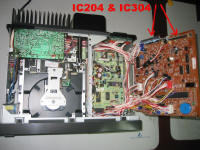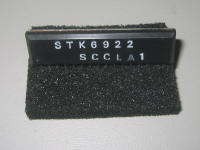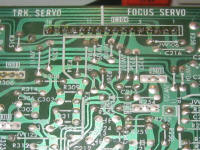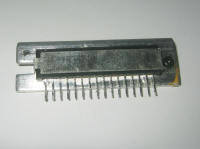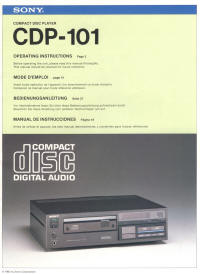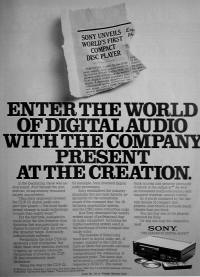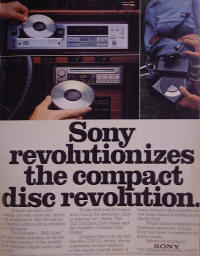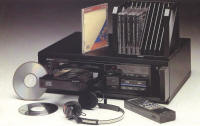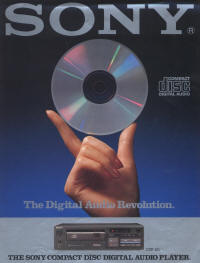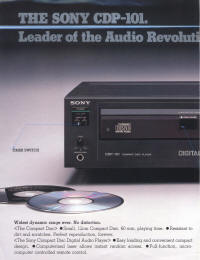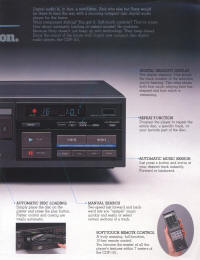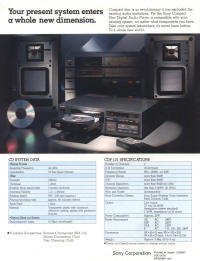Vand CD SONY CDP-101 Cu Telecomanda , Manual Utilizare , FOARTE RAR
CITESTE ORI CE CD-AUDIO INCLUSIY CELE ARSE PE PC
http://www.ebay.com/itm/SONY-CDP-101...item1e7159b45e ... It was
Philips that launched with the dual TDA1540 14-bit DAC plus creative ...
Sony CDP-101 Introduction
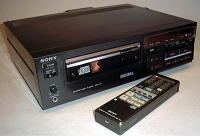
This is one of my oldest Hi-Fi friends and the one single thing that started me on the road of my interest in

high-end Hi-Fi and digital electronics, my first CD player ever,
the first CD player ever,
the Sony CDP-101 circa 1983! Before anyone in the U.S.A. even knew
what CD stood for where CD was not introduced until later in 1983, I had
my first CD system working in the summer of 1983 in England on August
5th! This then lead to the purchase of my first
Technics SE-A5 and my
Quad ESL-63 speakers,
a totally killer system that with the exception of the actual Sony
CDP-101 has lasted me a lifetime and is still in daily use! The whole
system was operational ready for me to get my first CD Christmas present
that year! If anyone had a CDP-101 before me,
please let me know! First introduced on
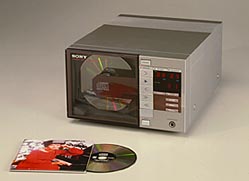
October 1st, 1982 in Japan, the Sony CDP-101 meaning Compact Disc
Player model five in digital binary notation, was so far ahead of its
time in terms of features and build quality, that apart from it's
obvious D/A digital limitations due to its age, it still looks like any
top of the line player that has not yet even been invented! This
product in it's day or any day for that matter shows the true inventive
power of the Sony CBS corporation and along with Phillips and Polygram,
without them we may still have been here now listening to vinyl and
singing the praises of the Technics SL-1200! I think it would be nice
if Sony were to release a 25th anniversary version of the CDP-101 in
gold plate like Technics have done with the
SL-1200 Gold  edition
edition,
although of course, while the SL-1200 is still very well known and is
still shipping, the old Sony CDP-101 has long since faded into the
annals of audio history and now everybody just assumes that CD has
existed forever! The "Goronta" shown to the right is the prototype
predecessor to the CDP-101 and as you can see has the disc is mounted
vertically and this is how all other first generation CD players were
made with the exception of the Phillips designs that were top loading
like old laservision machines. You can read more about this from Sony
here.
Trust Sony to come up with the sliding tray disc loading idea that
again everybody just assumes was always there. And just when you were
thinking that was it, there is more! Sony added an infrared remote
control! Again today this is just taken for granted, but most TV's in
1983 didn't even have a remote! As far as I know, the Sony CDP-101 is
the first ever widely available consumer electronics audio device to
have a remote. Wow, for me that made selecting the CDP-101 as my first
player a slam-dunk compared to anything else. There were 2 or 3 other
first generation CD players to choose from by the summer of 1983 and the
other main one I was looking at was the
Technics SL- P10
P10.
Of course this was also a vertical loading player and looked very good,
but the remote control feature on the Sony just eliminated the
SL-P10 from the picture immediately! So after deciding to go for the Sony, I headed to Tottenham Court

Road in London as that is where all the top Hi-Fi shops in England are
clustered and I set about finding the best price. Well, I was amazed to
find that not one single store had a single CD player in stock and this
was in August 1983. The sales guys in most stores just laughed and
said "
you will never get one, and if you did, it would cost thousands"!
I kept looking around and in one store, Arena Electronics where I was
getting the same story, there were a couple of Indian guys behind the
counter furiously talking in Hindi and just as I was about to leave,
they called the sales guy over and changed his mind for him. They told
me the the player would be waiting there for me the next day! I showed
the sales guy 4 CD's that I had just purchased from the
Virgin Mega Store in Oxford Street
and he told me to be sure and ask for him the next day. Sure enough the
next day the player was there and it was all hooked up for a demo &
the sales guy was just bursting to see what CD's I had for him. No
words can describe his disappointment when I showed him the only CD I
had on me that day,
Vivaldi's Four Seasons by the English Concert Orchestra,
but it played fine! The Sony CDP-101 cost me 550 GBP that day which
was about $850 at the time, and for 1983 that's quite a pricey piece of
gear! You can read an original review of the CDP-101 from stereophile
here.
Inside the Sony CDP-101

When
you open up the CDP-101 and compare it with a modern day player, the
first thing that strikes you is just how much of it there is! Even
though it contains the first LSI (Large Scale Integration) microchips in
any consumer electronics device that replaced over 500 ordinary
integrated circuits in prototype CD players, it is still stuffed full in
there and it is a wonder it ever worked reliably, but work it did. As
the digital to analog converter was of course one of the

most complex and costly components to produce back then, the player was
setup in such a way that the single converter was time shared
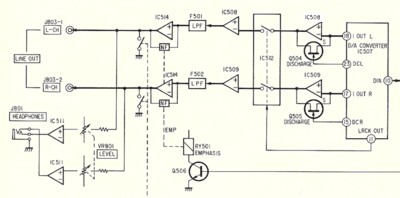
between
the two stereo channels, first calculating the output level for one
channel, and then working on the other channel and so on. You can see
the logical arrangement in the diagram to the left. These days, if a
single DAC were used, there would be sample & hold buffers to get
the samples for both channels in synch. So with CD having a sampling
rate of 44.1kHz per channel and two stereo channels, that means a total
of 88,200 samples per second, so dividing 1 second by 88200 gives about
11.34 micro seconds for each sample. So this means in fact that one
channel is always about 11 micro seconds behind the other. Although
very slight, this would causes an effect like you can hear when you
adjust the azimuth on a tape deck although very much harder to detect.
Comparing this problem with the effect you get by playing an LP with
anything other than a linear tracking turntable, the effect is
negligible and so in those days it was acceptable as the main
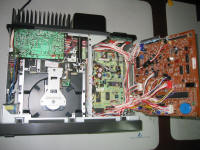
impact
of CD was the fantastic dynamic range and signal to noise ratio. The
only time you can actually really hear this effect is if you are playing
a Dolby Pro Logic surround sound disc and playing it through a surround
sound processor to split the sound into 4 channels (left, right, center
& rear surround) where exact phase is very important. Of course,
nobody was doing this in 1983 with CD's so it was really a bit of a non
issue. Having said all that though, there is some indication in the
circuit that some rather crude effort was made to solve this problem.
Look carefully at the circuit diagram of the Low Pass Filter section of
the output stage shown to the right. Notice that for the left channel
the feedback resistor (R530) is 15k ohms but for the right channel
(R541) it is 16k ohms. That 1k of difference with the 75pF capacitor
would give rise to an additional delay of about 75 micro seconds on its
own, but we have to assume that in combination with the complete circuit
it somehow resolves to around the 11.34 micro seconds required. This
issue though is why it is important to have properly synchronized
parallel phase converters in a
laserdisc player for watching surround sound films. The way I solved this in the end for the CD case was to replace the CDP-101 with a
Technics SL-P1000
in 1988 that has separate single chip converters for each channel.
Still, it's always a great way to test any self pronounced audiophile
experts that happen to be in my living room to see if they can tell the
difference... The tiny difference in phase that still exists is
probably the only way to tell this CD player from any with parallel
converters apart from the usual discussions about the tonal differences.
Remote Control
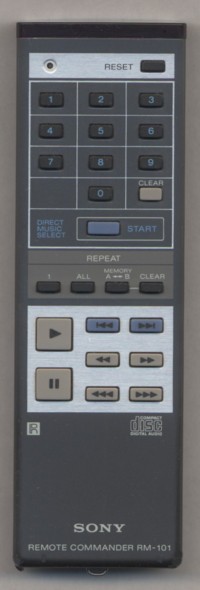
Clearly by adding an elegant infrared remote control handset to the
CDP-101, Sony were blazing the trail for the CD concept in every
aspect! Like the player, the handset is as futuristic as anything you
could imagine! With a slightly squareish profile by today's standards
the handset is built tough with a stylish painted brushed aluminum clad
top and soft rubber buttons like any remote of today, but it has a
weight & feel that no modern day remote can touch. On the sides of
the remote, there are some

sliding covers that run almost the whole length of the handset and when
you remove them, they reveal nothing but the slot from which they
came. I have always presumed since first seeing this that Sony would
soon make a receiver or something with a similar design and provide a
fluted slide that could join two remotes together. As far as I know
they never did and the design was abandoned. When you press a button,
there is a small light that blinks on the player, just like a 1980's
TV. There is also a switch on the bottom of the player that when
switched on causes a little "
beep" sound at every button press.
The sound is actually quite smooth & cute and not like the cheep
sounding beep of modern electronics and shows just how hard Sony were
working on every detail. As one of the primary challenges in the
integration of the large audio & video setup's I have built over the
years is the detailed understanding of infrared remote control, it is
fitting that I should describe the detail of this handset first, as
first it was indeed, although of course it is no longer used in my
primary system. This may also be vital information if you are trying to
build a replacement for the Sony RM-101 Remote Commander or program
some other device to use with a CDP-101!
Just like all remote handsets of today, the Sony RM-101 uses a
modulated pulse position protocol to signal the CDP-101 player. The
player looks for pulsing light in the area of the modulating carrier
frequency which is 40kHz, and by looking at the length of each modulated
burst, can detect binary 1's and 0's, so this too is a simple digital
device that uses a kind of pulse position modulation. Referring to
figure 1 below, this shows part of a
PCRemote
screen shot and is the display of the RM-101 Play button. As you can
see, there is one wide pulse to start with, which is a synchronization
start pulse, then 12 following pulses, some wider than others. The thin
pulses represent a binary value of 0, and the wider pulses a binary
value of 1. So going from left to right, the 12 bit value is
010011010001.
By looking at the codes from all the other buttons, I have established
two things: First, the data appears to be sent with the least
significant bit first, but the
PCRemote display is merely concerned with time going from left to right, so for us to read it as a number it needs to be reversed as
100010110010. Second, I can see that all the pulses start with
100010, so it is possible this is a 6 bit device code, and the remaining 6 bits
110010,
are the button code, so this would give 64 possible devices with up to
64 buttons each. In fact, further research into this indicates that
Sony uses (or used to back in the 80's) a 5 bit word code and a 7 bit
data code. The total data packet is about 20 milliseconds long and
there is another 20 millisecond gap at the end before the pattern is
repeated. The repetition goes on and on for as long as a button is held
down.
Figure 1. PCRemote display of RM-101 Play button at scale 9 showing entire data packet
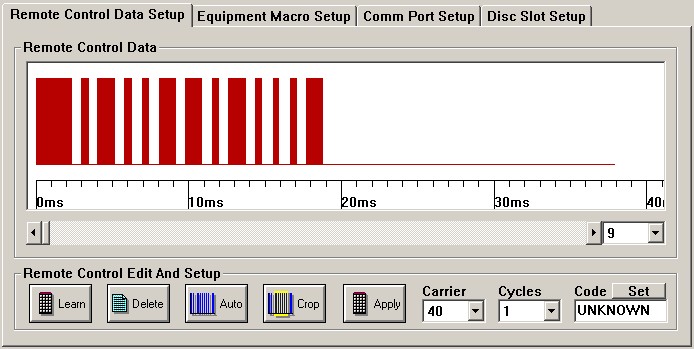
Looking more closely at the pulses in Figure 2 below we can see more
detail about the pulse durations. The starting synchronization pulse is
2.4 milliseconds long and then each data bit is a 0.6 millisecond gap
followed by a 0.6 millisecond pulse for a binary 0, or a 0.6 millisecond
gap followed by a 1.2 millisecond pulse for a binary 1. So the
duration of the shortest data packet with the value of 000000000000
would be 2.4 + ((0.6 + 0.6) x 12) = 16.8 milliseconds. The duration of
the longest data packet with the value of 111111111111 would be 2.4 +
((0.6 + 1.2) x 12) = 24 milliseconds. Just for your information, the
numbers on the top row of the
PCRemote
display are the pulse numbers starting from 0 and counting to the
right, the second row of numbers is the actual count of the number of
40kHz cycles that is needed to fill the amount of time of the pulse or
gap width. It is data at this level that
PCRemote actually records and uses for playback of the pattern to emulate a button press. So in fact,
PCRemote
does not need to know anything about the details of the protocol we are
discussing here, it just records and plays back the pattern of pulses
it sees! This is in fact how all learning remotes work and why they use
so much memory for learning something so simple! They are just not
smart enough to learn the actual protocol like we are here! But at
least with
PCRemote the user can
see
what the application is recording and redo any recordings that are
obviously wrong. That can sometimes happen if you have fluorescent and
especially neon tube lights on in the same room as the receiver.
Figure 2. PCRemote display of RM-101 Play button at scale 40 showing detail of pulse sizes
The following table shows the binary values of all the buttons on the
RM-101 The codes are shown as 12 bit binary numbers and as described
above (least significant bit on the right but first to be transmitted),
this makes the code for play 10001 0110010 and they are divided
into a bunch of 5 and 7 just to make them easier to see and are listed
in order of numerical code. This information can be used to manufacture
a new RM-101 remote or you can convert the data into pulse width times
for entry into some kind of other intelligent remote control transmitter
device to use with a CDP-101 if you have lost your RM-101!
| Sony RM-101 Remote |
Button |
Code |
 |
1 |
10001 0000000 |
| 2 |
10001 0000001 |
| 3 |
10001 0000010 |
| 4 |
10001 0000011 |
| 5 |
10001 0000100 |
| 6 |
10001 0000101 |
| 7 |
10001 0000110 |
| 8 |
10001 0000111 |
| 9 |
10001 0001000 |
| 0 |
10001 0001001 |
| Clear |
10001 0001111 |
| Start |
10001 0011100 |
| Memory A-B |
10001 0101010 |
| Clear A-B |
10001 0101011 |
| Repeat All |
10001 0101100 |
| Repeat 1 |
10001 0101101 |
| Skip Back |
10001 0110000 |
| Skip Forward |
10001 0110001 |
| Play |
10001 0110010 |
| Scan Back Fast |
10001 0110011 |
| Scan Forward Fast |
10001 0110100 |
| Reset |
10001 0111000 |
| Pause |
10001 0111001 |
| Scan Back Slow |
10001 0111010 |
| Scan Forward Slow |
10001 0111011 |
CDP-101 Problems
| Focus Search Operation Check |
| Disc Ejection after Disk Table Closing |
| Defective Disc Table Open or Close, Defective Chucking |
| SCAN Continues Even When PLAY Switch is Pressed |
| Delayed Play Start and no Scan and Skipping |
| SCAN Continues in Play (SCAN Indication does not go out) |
| SCAN Continues in PLAY Mode and a Squeaking Noise |
| No Operation When POWER is Turned On (1) |
| No Operation When POWER is Turned On (2) |
| When Any SCAN is Pressed, Only Fast SCAN Occurs |
| Slow SCAN Forward Only Cannot be Accessed |
| For Open Close During Play, the Disc Table Opens Before Disc Stops Rotating |
| Noise During POWER OFF |
| No Remote Control Operation |
| No Sound |
| Sound Skipping |
| Rapid Blip Noise |
| Display Tube Does Not Light Up |
| Defective Display (Set Operates Normally) |
| LAP Time Not Displayed |
After a quarter of a century of usage, it is only fair that a CDP-101
should have a failure or two. Having said that, mine failed in about
1985 which I didn't feel was that good at the time! It therefore
effectively suffered the same fate as every other piece of Sony
equipment I have ever owned including the first ever Video 8 recorder
with digital audio the EVS-700 and the first ever small head Video 8
HandyCam camcorder the TR-55. While all of these items did indeed work
at one point and continued to do so through their warrantee period and
were purchased at a time when each of them was incredibly difficult to
make, they all failed after a relatively short time compared with other
equipment I have. While it was great to have such futuristic equipment
at the time, it's a shame that it all busted so quickly! So while Sony
clearly has a significant leadership position in design concepts, I
can't say as I'm that impressed with the equipment. Even within the
last month, I have found two items of Sony equipment just discarded in
the garbage at our condo (yes, I'm rooting through the garbage again!),
an STR-DE915 receiver and a CDP-297 CD player. How come I never see any
Pioneer or Technics gear tossed away there? After a little research I
find that anyone who has had the misfortune to own an STR-DE915 receiver
will never have anything good to say about Sony again and I think it is
a shame that Sony puts their name on such poorly designed equipment,
although the CDP-297 is up and running straight out of the trash can and
works with the RM-101 remote! As far as my CDP-101 is concerned, it
sat for many many years just gathering dust waiting for a service manual
to come along. Well, now I have one, so let's see what can be done!
What was happening with the player back in 1985, was that it did start
to play the disc, but then started to skip and jump around. Then a
knocking noise starts to come from the focus servo and it is
unbelievable how loud the noise gets, so I would unplug it before it
exploded! Now, there is also another problem, the drive for the loading
draw has failed so you have to take the lid off to get the disc in!
So the two problems are: Disc skipping which gets worse and worse the
longer the player runs; Second, the loading draw is stuck. From all I
have heard about CDP-101's, these are the two classic and most prominent
problems. If your CDP-101 has not had either issue yet, one day it
will. The CDP-101 Troubleshooting Guide lists the problems shown in the
table above and the sequence of actions needed to solve them. Problem
is, neither of these things are listed. The section about "Sound
Skipping" just tells you to clean the sled drive and to replace the rack
if needed. Hmm, well I did hear from one guy in Germany who said that
cleaning and lubricating the sled drive did work for him, so I guess
that would be worth a try. But from the amazing knocking and banging
going on under the hood, I can tell you that an oil change is not going
to work in this case!
STK6922 Causing Disc Skipping

Looking
at the block diagram of the CDP-101 in the service manual and knowing
that the knocking noise is coming from the sled or the laser
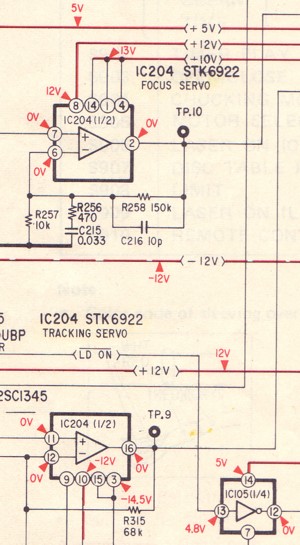
assembly (or both), following back from the optical units focus &
tracking servo leads to IC204, the motor driver. Following back from
the sled motor and the chucking (the 4 lifting feet in the tray) motor
leads to IC304, motor driver again. Each of these chips is an STK6922
and each has two drivers. The output pins for each are pin 2 and pin 16
(pin numbers are on the back board) and the +ve and -ve inputs for each
driver are 7 & 6 and 11 & 12 respectively as shown in the
diagram to the right.
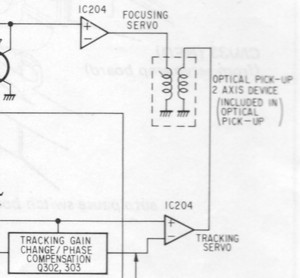
According
to the service manual in idle conditions, all of these pins should show
0 volts for IC204 and IC304. Once warmed up, my CDP-101 would just
start clicking and knocking of it's own accord with no disc loaded, so I
just had to be looking between the right two pins at the right time to
see what was going on. This test showed spurious voltages on the
outputs of IC204 on both pin 2 and 16. A couple of times I also noticed
the sled motor twitch but I never saw any confirmed results on IC304.
Either way, this looked like the problem area and searching the net
indicated others had changed both these chips, so I decided to replace
them both. Once both chips were replaced, the player ran fine, at least
so far! This is lucky, as I expected I would have to adjust the focus
gain at the very least, but it looks like
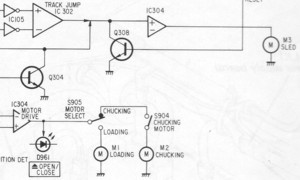
that
was all that was needed. There are streams and streams of other
adjustments and checks in the service manual and in some cases, other
adjustments will be needed, so if you do this repair, just this may not
be all that is needed. I picked up my service manual on eBay and this
is where to look if you need one or I know that
www.hifimanuals.com has copied versions of them
here. While these chips are old and rare,
here
is one supplier I found who has a page for the STK6922 and sometimes
you can find them on eBay. Later model CDP-101's used the BX1201 in
place of the STK6922, so you could try that also. The missing pins on
the BX1201 are not needed and were grounds on the STK6922 so the BX1201
is in fact a pin for pin replacement. Only problem is that the gain is a
bit different so the focus and tracking servo gain will need to be
adjusted if you substitute one chip for another. Good luck if you try
this out! I have heard from many people who have had good luck with
this repair with both chip types. More recently,
Stephen Lafferty has published
a paper that describes how to build a complete replacement for the old STK6922 using two
LM1875 audio amplifier chips.
Click here to link to Stephens CDP-101 page.
Oil Change Needed to Free Loading Draw
OK, I take back everything I said about this thing not needing an oil
change! The reason that the loading draw was not working is that the
grease used to lubricate the moving parts had dried up and actually gone
solid in some places. In fact not only was the draw stuck, but I also
noticed that the chucking mechanism that lifts the disc up and down was
straining and slow. The best thing would be to go through the whole
unit can change all the oil! Having said that, many parts do not really
need oil and just cleaning them up with some Goo-Gone did the job for
me. The particular part causing the draw to stick in my case is shown
in the pictures below. You need to remove the bottom of the player and
lift the bottom circuit board up to get access. This means removing the
5 screws that hold it and cutting some of the straps from the cabling
above. That means removing the top of the player and removing the two
screws that retain the top folding board. All quite easy

















 P10
P10 Road in London as that is where all the top Hi-Fi shops in England are
clustered and I set about finding the best price. Well, I was amazed to
find that not one single store had a single CD player in stock and this
was in August 1983. The sales guys in most stores just laughed and
said "you will never get one, and if you did, it would cost thousands"!
I kept looking around and in one store, Arena Electronics where I was
getting the same story, there were a couple of Indian guys behind the
counter furiously talking in Hindi and just as I was about to leave,
they called the sales guy over and changed his mind for him. They told
me the the player would be waiting there for me the next day! I showed
the sales guy 4 CD's that I had just purchased from the
Road in London as that is where all the top Hi-Fi shops in England are
clustered and I set about finding the best price. Well, I was amazed to
find that not one single store had a single CD player in stock and this
was in August 1983. The sales guys in most stores just laughed and
said "you will never get one, and if you did, it would cost thousands"!
I kept looking around and in one store, Arena Electronics where I was
getting the same story, there were a couple of Indian guys behind the
counter furiously talking in Hindi and just as I was about to leave,
they called the sales guy over and changed his mind for him. They told
me the the player would be waiting there for me the next day! I showed
the sales guy 4 CD's that I had just purchased from the  When
you open up the CDP-101 and compare it with a modern day player, the
first thing that strikes you is just how much of it there is! Even
though it contains the first LSI (Large Scale Integration) microchips in
any consumer electronics device that replaced over 500 ordinary
integrated circuits in prototype CD players, it is still stuffed full in
there and it is a wonder it ever worked reliably, but work it did. As
the digital to analog converter was of course one of the
When
you open up the CDP-101 and compare it with a modern day player, the
first thing that strikes you is just how much of it there is! Even
though it contains the first LSI (Large Scale Integration) microchips in
any consumer electronics device that replaced over 500 ordinary
integrated circuits in prototype CD players, it is still stuffed full in
there and it is a wonder it ever worked reliably, but work it did. As
the digital to analog converter was of course one of the most complex and costly components to produce back then, the player was
setup in such a way that the single converter was time shared
most complex and costly components to produce back then, the player was
setup in such a way that the single converter was time shared 


 sliding covers that run almost the whole length of the handset and when
you remove them, they reveal nothing but the slot from which they
came. I have always presumed since first seeing this that Sony would
soon make a receiver or something with a similar design and provide a
fluted slide that could join two remotes together. As far as I know
they never did and the design was abandoned. When you press a button,
there is a small light that blinks on the player, just like a 1980's
TV. There is also a switch on the bottom of the player that when
switched on causes a little "beep" sound at every button press.
The sound is actually quite smooth & cute and not like the cheep
sounding beep of modern electronics and shows just how hard Sony were
working on every detail. As one of the primary challenges in the
integration of the large audio & video setup's I have built over the
years is the detailed understanding of infrared remote control, it is
fitting that I should describe the detail of this handset first, as
first it was indeed, although of course it is no longer used in my
primary system. This may also be vital information if you are trying to
build a replacement for the Sony RM-101 Remote Commander or program
some other device to use with a CDP-101!
sliding covers that run almost the whole length of the handset and when
you remove them, they reveal nothing but the slot from which they
came. I have always presumed since first seeing this that Sony would
soon make a receiver or something with a similar design and provide a
fluted slide that could join two remotes together. As far as I know
they never did and the design was abandoned. When you press a button,
there is a small light that blinks on the player, just like a 1980's
TV. There is also a switch on the bottom of the player that when
switched on causes a little "beep" sound at every button press.
The sound is actually quite smooth & cute and not like the cheep
sounding beep of modern electronics and shows just how hard Sony were
working on every detail. As one of the primary challenges in the
integration of the large audio & video setup's I have built over the
years is the detailed understanding of infrared remote control, it is
fitting that I should describe the detail of this handset first, as
first it was indeed, although of course it is no longer used in my
primary system. This may also be vital information if you are trying to
build a replacement for the Sony RM-101 Remote Commander or program
some other device to use with a CDP-101! 
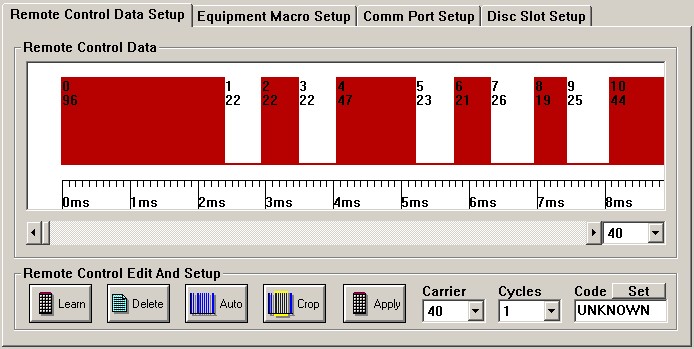
 Looking
at the block diagram of the CDP-101 in the service manual and knowing
that the knocking noise is coming from the sled or the laser
Looking
at the block diagram of the CDP-101 in the service manual and knowing
that the knocking noise is coming from the sled or the laser assembly (or both), following back from the optical units focus &
tracking servo leads to IC204, the motor driver. Following back from
the sled motor and the chucking (the 4 lifting feet in the tray) motor
leads to IC304, motor driver again. Each of these chips is an STK6922
and each has two drivers. The output pins for each are pin 2 and pin 16
(pin numbers are on the back board) and the +ve and -ve inputs for each
driver are 7 & 6 and 11 & 12 respectively as shown in the
diagram to the right.
assembly (or both), following back from the optical units focus &
tracking servo leads to IC204, the motor driver. Following back from
the sled motor and the chucking (the 4 lifting feet in the tray) motor
leads to IC304, motor driver again. Each of these chips is an STK6922
and each has two drivers. The output pins for each are pin 2 and pin 16
(pin numbers are on the back board) and the +ve and -ve inputs for each
driver are 7 & 6 and 11 & 12 respectively as shown in the
diagram to the right.  According
to the service manual in idle conditions, all of these pins should show
0 volts for IC204 and IC304. Once warmed up, my CDP-101 would just
start clicking and knocking of it's own accord with no disc loaded, so I
just had to be looking between the right two pins at the right time to
see what was going on. This test showed spurious voltages on the
outputs of IC204 on both pin 2 and 16. A couple of times I also noticed
the sled motor twitch but I never saw any confirmed results on IC304.
Either way, this looked like the problem area and searching the net
indicated others had changed both these chips, so I decided to replace
them both. Once both chips were replaced, the player ran fine, at least
so far! This is lucky, as I expected I would have to adjust the focus
gain at the very least, but it looks like
According
to the service manual in idle conditions, all of these pins should show
0 volts for IC204 and IC304. Once warmed up, my CDP-101 would just
start clicking and knocking of it's own accord with no disc loaded, so I
just had to be looking between the right two pins at the right time to
see what was going on. This test showed spurious voltages on the
outputs of IC204 on both pin 2 and 16. A couple of times I also noticed
the sled motor twitch but I never saw any confirmed results on IC304.
Either way, this looked like the problem area and searching the net
indicated others had changed both these chips, so I decided to replace
them both. Once both chips were replaced, the player ran fine, at least
so far! This is lucky, as I expected I would have to adjust the focus
gain at the very least, but it looks like  that
was all that was needed. There are streams and streams of other
adjustments and checks in the service manual and in some cases, other
adjustments will be needed, so if you do this repair, just this may not
be all that is needed. I picked up my service manual on eBay and this
is where to look if you need one or I know that
that
was all that was needed. There are streams and streams of other
adjustments and checks in the service manual and in some cases, other
adjustments will be needed, so if you do this repair, just this may not
be all that is needed. I picked up my service manual on eBay and this
is where to look if you need one or I know that 